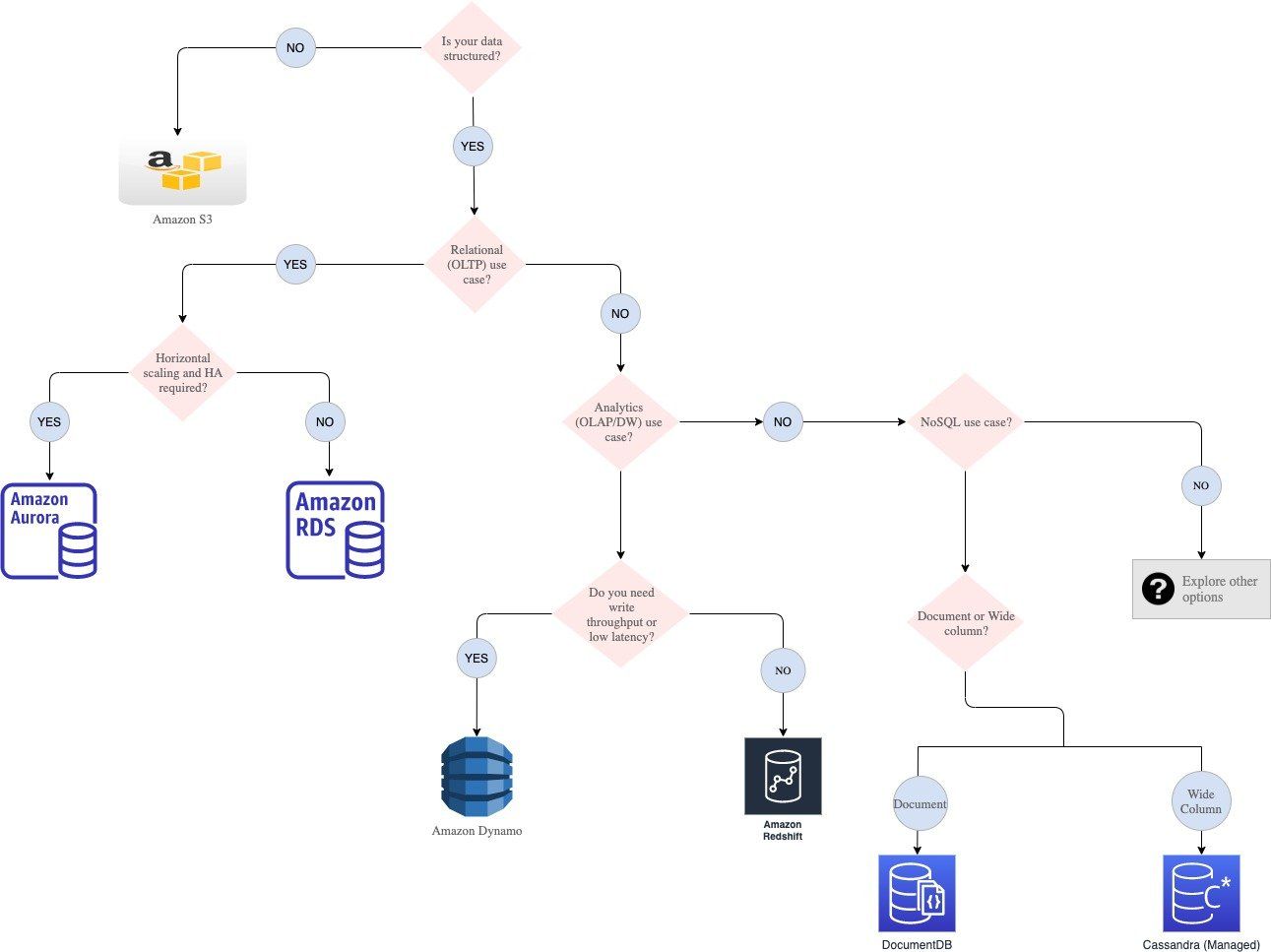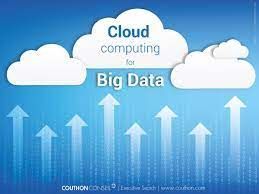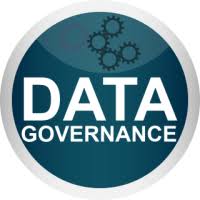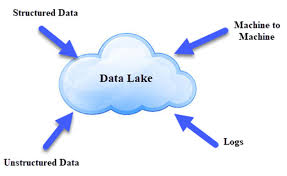Amazon AWS Cloud Managed Database Services
Srinivasa Rao • April 21, 2020
Database options on Amazon AWS

| Type | Name | Description | Usage |
|---|---|---|---|
| Key value | Amazon Dynamo | Horizontally scalable key value store | key-value and document database. provides millisecond response times. High-traffic web apps, e-commerce systems, gaming applications |
| Relational | Amazon RDS | SQL Server, MySQL, MariaDB, Oracle and SQL Server and Amazon Aurora | Aurora is faster than MySQL and PostgreSQL and cheaper. Can be used for traditional relational database needs. Used strong ACID needs arise. |
| Analytical/Data warehouse | Redshift | Horizontally scalable Data warehouse database | Can be used where we need to perform analytical queries on huge amounts of data with very low updates and when some latencies are ok. |
| NoSQL/Wide column | Cassandra Managed service | Horizontally scalable NoSQL Database. | Where updates and low-latency data requirements are needed like streaming. Very good for huge write throughputs. Faster reads when queried on primary or partition keys. |
| NoSQL/Document | Amazon DocumentDB | Horizontally scalable non-relational NoSQL database | Supports mongoDB workloads. Makes it easy to store, query and index JSON data. |
| In-memory/Cache | Amazon ElastiCache (Memcached, Redis) | In-memory cache database | Used for caching, session management and any intermediator caching need. |
| Amazon S3 | Dynamically scalable object store | Dynamically scalable object store | Used to store raw data files that include incoming data files from source systems and any unstructured files. This can be the base of the data lake. This serves raw data lake layer. Similar to HDFS in Hadoop environment. |
Amazon S3
Amazon Simple Storage is a managed object store service provided by AWS. It is a distributed, high-scalable, high available cloud storage. It can be used in place of HDFS like your on-premise Hadoop data lakes where it becomes foundation of your data lake. It can also be used to store unstructured data, content and media, backups and archives and so on.
Cassandra Managed service
Amazon Managed Apache Cassandra Service is a scalable, highly available, and managed Apache Cassandra–compatible database service. Cassandra is very good for application which have very high throughput and supports faster reads when queries on primary or partition keys. It provides sub milliseconds response times.
Amazon ElastiCache
Amazon ElasticCache is managed service that supports Memcached and Redis implementations. This service improves performance of the web applications by allowing to store information in in-memory cache and then retrieve information from fast in-memory caches, instead of making multiple trips to slower backend databases.
This can also be used to store static content on web and also used as fast layer in lambda architecture.
Amazon DocumentDB
Amazon DocumentDB is a fully managed document-oriented database service which supports JSON data workloads. It is MongoDB compatible. Its fast, high available and scales over huge amounts of data.
Redshift
Amazon Redshift is a fast, fully managed analytical data warehouse database service scales over petabytes of data. Amazon Redshift provides a standard SQL interface that lets organizations use existing business intelligence and reporting tools. Amazon Redshift is a columnar database and distributed over multiple nodes allows to process requests parallel on multiple nodes.
Amazon RDS
Amazon Relational database service(RDS) provides a fully managed relational databases both open source and commercial database engines. It supports MySQL, PostgreSQL, Oracle, SQL Server and Amazon Aurora. You can also bring your own license if you have one internally. Amazon RDS manages all operations, support related tasks internally.
Amazon Dynamo
Amazon Dynamo is a distributed wide column NoSQL database can be used by application where it needs consistent and millisecond latency at any scale. It is fully managed and can be used for document and wide column data models. It also supports flexible schema and can be used for web, ecommerce, streaming, gaming and IOT use cases.
The author has extensive experience in Big Data Technologies and worked in the IT industry for over 25 years at various capacities after completing his BS and MS in computer science and data science respectively. He is certified cloud architect and holds several certifications from Microsoft and Google. Please contact him at srao@unifieddatascience.com if any questions.

Database types Realtime DB The database should be able to scale and keep up with the huge amounts of data that are coming in from streaming services like Kafka, IoT and so on. The SLA for latencies should be in milliseconds to very low seconds. The users also should be able to query the real time data and get millisecond or sub-second response times. Data Warehouse (Analytics) A data warehouse is specially designed for data analytics, which involves reading large amounts of data to understand relationships and trends across the data. The data is generally stored in denormalized form using Star or Snowflake schema. Data warehouse is used in a little broader scope, I would say we are trying to address Data Marts here which is a subset of the data warehouse and addresses a particular segment rather than addressing the whole enterprise. In this use case, the users not only query the real time data but also do some analytics, machine learning and reporting. OLAP OLAP is a kind of data structure where the data is stored in multi-dimensional cubes. The values (or measures) are stored at the intersection of the coordinates of all the dimensions.

This blog puts together Infrastructure and platform architecture for modern data lake. The following are taken into consideration while designing the architecture: Should be portable to any cloud and on-prem with minimal changes. Most of the technologies and processing will happen on Kubernetes so that it can be run on any Kubernetes cluster on any cloud or on-prem. All the technologies and processes use auto scaling features so that it will allocate and use resources minimally possible at any given time without compromising the end results. It will take advantage of spot instances and cost-effective features and technologies wherever possible to minimize the cost. It will use open-source technologies to save licensing costs. It will auto provision most of the technologies like Argo workflows, Spark, Jupyterhub (Dev environment for ML) and so on, which will minimize the use of the provider specific managed services. This will not only save money but also can be portable to any cloud or multi-cloud including on-prem. Concept The entire Infrastructure and Platform for modern data lakes and data platform consists of 3 main Parts at very higher level: Code Repository Compute Object store The main concept behind this design is “Work anywhere at any scale” with low cost and more efficiently. This design should work on any cloud like AWS, Azure or GCP and on on-premises. The entire infrastructure is reproducible on any cloud or on-premises platform and make it work with some minimal modifications to code. Below is the design diagram on how different parts interact with each other. The only pre-requisite to implement this is Kubernetes cluster and Object store.

Spark-On-Kubernetes is growing in adoption across the ML Platform and Data engineering. The goal of this blog is to create a multi-tenant Jupyter notebook server with built-in interactive Spark sessions support with Spark executors distributed as Kubernetes pods. Problem Statement Some of the disadvantages of using Hadoop (Big Data) clusters like Cloudera and EMR: Requires designing and build clusters which takes a lot of time and effort. Maintenance and support. Shared environment. Expensive as there are a lot of overheads like master nodes and so on. Not very flexible as different teams need different libraries. Different cloud technologies and on-premises come with different sets of big data implementations. Cannot be used for a large pool of users. Proposed solution The proposed solution contains 2 parts, which will work together to provide a complete solution. This will be implemented on Kubernetes so that it can work on any cloud or on-premises in the same fashion. I. Multi-tenant Jupyterhub JupyterHub allows users to interact with a computing environment through a webpage. As most devices have access to a web browser, JupyterHub makes it easy to provide and standardize the computing environment of a group of people (e.g., for a class of data scientists or an analytics team). This project will help us to set up our own JupyterHub on a cloud and leverage the cloud's scalable nature to support large groups of users. Thanks to Kubernetes, we are not tied to a specific cloud provider. II. Spark on Kubernetes (SPOK) Users can spin their own spark resources by creating sparkSession. Users can request several executors, cores per executor, memory per executor and driver memory along with other options. The Spark environment will be ready within a few seconds. Dynamic allocation will be used if none of those options are chosen. All the computes will be terminated if they’re idle for 30 minutes (or can be set by the user). The code will be saved to persistent storage and available when the user logs-in next time. Data Flow Diagram

Data Governance on cloud is a vast subject. It involves lot of things like security and IAM, Data cataloging, data discovery, data Lineage and auditing. Security Covers overall security and IAM, Encryption, Data Access controls and related stuff. Please visit my blog for detailed information and implementation on cloud. https://www.unifieddatascience.com/security-architecture-for-google-cloud-datalakes Data Cataloging and Metadata It revolves around various metadata including technical, business and data pipeline (ETL, dataflow) metadata. Please refer to my blog for detailed information and how to implement it on Cloud. https://www.unifieddatascience.com/data-cataloging-metadata-on-cloud Data Discovery It is part of the data cataloging which explained in the last section. Auditing It is important to audit is consuming and accessing the data stored in the data lakes, which is another critical part of the data governance. Data Lineage There is no tool that can capture data lineage at various levels. Some of the Data lineage can be tracked through data cataloging and other lineage information can be tracked through few dedicated columns within actual tables. Most of the Big Data databases support complex column type, it can be tracked easily without much complexity. The following are some examples of data lineage information that can be tracked through separate columns within each table wherever required. 1. Data last updated/created (add last updated and create timestamp to each row). 2. Who updated the data (data pipeline, job name, username and so on - Use Map or Struct or JSON column type)? 3. How data was modified or added (storing update history where required - Use Map or Struct or JSON column type). Data Quality and MDM Master data contains all of your business master data and can be stored in a separate dataset. This data will be shared among all other projects/datasets. This will help you to avoid duplicating master data thus reducing manageability. This will also provide a single source of truth so that different projects don't show different values for the same. As this data is very critical, we will follow type 2 slowly changing dimensional approach which will be explained my other blog in detail. https://www.unifieddatascience.com/data-modeling-techniques-for-modern-data-warehousing There are lot of MDM tools available to manage master data more appropriately but for moderate use cases, you can store this using database you are using. MDM also deals with central master data quality and how to maintain it during different life cycles of the master data. There are several data governance tools available in the market like Allation, Collibra, Informatica, Apache Atlas, Alteryx and so on. When it comes to Cloud, my experience is it’s better to use cloud native tools mentioned above should be suffice for data lakes on cloud/




